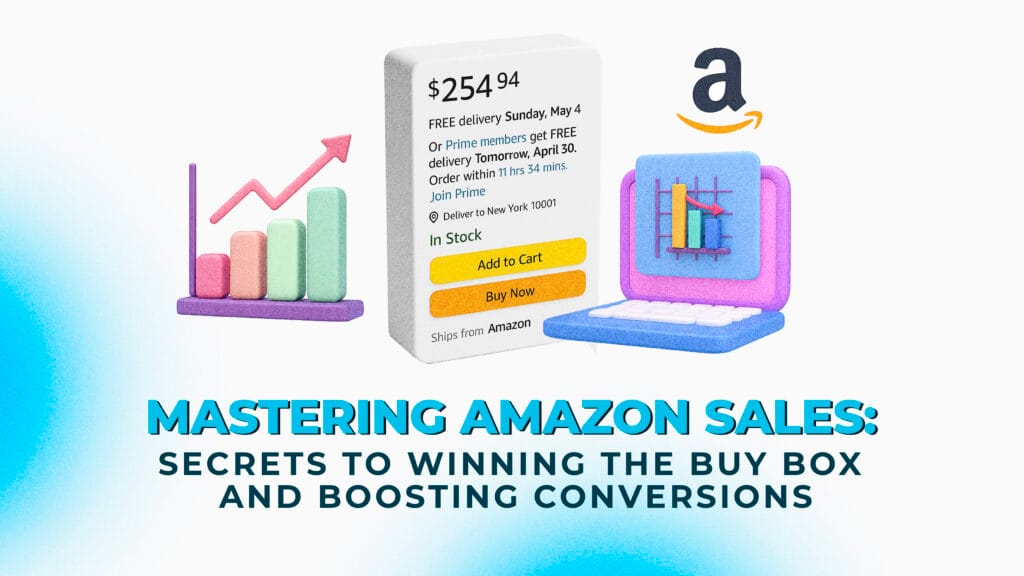Amazon Sales Explained: How to Win the Buy Box

Selling on Amazon is one of the most powerful ways to build a profitable e-commerce business. With millions of active buyers and a platform built for scale, the opportunity is huge. But to succeed, you need more than just listing a product; you need a clear strategy to win the Buy Box and increase your conversions. In this guide, we’ll break down how Amazon sales work, what the Buy Box is, and how you can improve your listings and strategy to generate more sales. What Is the Amazon Buy Box? When customers look at a product on Amazon, the “Buy Box” is the section on the right-hand side of the page where they click “Add to Cart” or “Buy Now.” For mobile users, it’s often the first thing they see. What many new sellers don’t realize is that multiple sellers can offer the same product, but only one wins the Buy Box at a time. That placement drives most sales. In fact, over 80% of Amazon sales go through the Buy Box, which makes winning it essential for growth. Why the Buy Box Matters Here’s why the Buy Box is so important to your success on Amazon: If you’re not in the Buy Box, your product may still be listed, but it may be buried under “Other Sellers,” which most customers don’t explore. How Amazon Chooses the Buy Box Winner Amazon uses a performance-based algorithm to determine which seller gets the Buy Box. Price is a factor, but not the only one. Here are the main criteria Amazon considers: 1. Competitive Pricing Amazon evaluates the total price, including item cost and shipping. You don’t always have to be the lowest, just competitive. A fair price from a well-performing seller can often beat a lower-priced but lower-rated seller. 2. Fulfillment Method Fulfilled by Amazon (FBA) sellers have a better chance of winning the Buy Box because Amazon handles fast shipping and customer service. If you use Fulfilled by Merchant (FBM), you need to offer reliable, fast shipping and top-tier customer support. 3. Order Defect Rate and Seller Performance Amazon looks at your account health. This includes your order defect rate, late shipments, cancellations, and customer service quality. Keeping these metrics strong improves your chances. 4. Inventory Availability If your product is out of stock, you lose the Buy Box, no matter how strong your metrics are. Keeping inventory levels healthy is key to staying competitive. How to Increase Amazon Sales by Optimizing Your Listing Winning the Buy Box brings traffic. But to convert that traffic into paying customers, your product listing needs to be clear, compelling, and optimized. Here’s how to improve your product page: Use Clear, Keyword-Rich Titles Your title should include the brand name, product type, key features (like size or quantity), and relevant keywords. Avoid keyword stuffing and make sure it reads naturally. Write Informative Bullet Points Use 3–5 bullet points to highlight your product’s benefits. Focus on what problems it solves, how it improves the buyer’s life, and any key features that set it apart. Create a Strong Product Description Tell a simple, benefit-focused story. Explain what your product does, who it’s for, and why it’s better than the competition. Break text into short paragraphs for easier reading. Use High-Quality Images Your images should be clear, high resolution, and meet Amazon’s guidelines. Show the product from different angles, include scale reference, and add lifestyle images to help customers picture it in use. Get More Reviews Social proof drives conversions. After each purchase, use Amazon’s built-in “Request a Review” button. You can also use email follow-ups (if compliant with Amazon’s policies) to encourage satisfied customers to leave feedback. Advanced Tips to Drive Even More Sales Once your basics are in place, here are a few advanced tactics to further boost your Amazon sales. Invest in Amazon Advertising Sponsored Product ads can place your listings at the top of search results. Start with automatic campaigns to gather data, then move to manual targeting for better control. Offer Coupons and Promotions Coupons and lightning deals can help your product stand out. A small discount can lead to a big jump in sales, especially if you’re in a competitive category. Use Subscribe & Save If you sell consumable items like vitamins, cleaning products, or snacks, offering a subscription option can attract repeat customers and stabilize monthly revenue. Optimize Backend Keywords Include high-ranking keywords in your backend search terms (the hidden keywords section in Seller Central). These help your product show up in search without crowding your visible listing. Monitor Competitors Regularly check your top competitors’ listings, pricing, and reviews. Use tools like Helium 10 or Jungle Scout to find gaps or missed opportunities. Common Mistakes to Avoid Many sellers struggle to grow because they ignore the basics. Here are a few common pitfalls: Fixing just one of these issues can result in a noticeable increase in your Amazon sales. Final Thoughts: Selling Smarter on Amazon Growing your Amazon business takes more than just uploading a product and hoping for the best. Success comes from understanding how Amazon works, optimizing every part of your listing, and earning Amazon’s trust so you can win the Buy Box. Once you start consistently doing these things, your visibility and conversion rates will increase, and so will your profits. Ready to Grow Your Amazon Sales? At Brand Aventus, we help sellers like you: Running an Amazon store takes time, knowledge, and consistency. Let us handle the hard parts while you focus on growing your brand. Book a free strategy call today and discover how Brand Aventus can take your Amazon business to the next level. Visit: www.brandaventus.com
Use Video to Skyrocket Amazon Sales – The secret Weapon

If you are struggling with Amazon Sales and not using video, you’re leaving money on the table. Imagine this: You’re shopping online, scrolling through products, and you see one with a short, fun video showing how it works. You’d probably click on it, right? You might even buy it. That’s the power of video. In this post, we’ll reveal why video is the secret weapon that can help you sell more, build trust, and grow your Amazon business like never before. Best of all? Most sellers still don’t use it correctly. But you will, after this. Video Works Like Magic (and the Stats Prove It) People love watching videos. In fact, 69% of customers say they’d rather learn about a product through a video than through text or pictures. And 84% of people say a brand’s video convinced them to buy something. That’s huge! Even more interesting, 43% of shoppers say they want more videos from brands. Plus, 71% say it’s their favorite kind of marketing. Still not convinced? Think about this: over 3.1 billion people around the world are watching digital videos. And 96% of customers say they find product videos super helpful when deciding to buy online. That’s almost everyone! Shoppers Love Product Videos Shopping online can be confusing. You can’t touch the product, so you can’t try it. So, how do you know if it’s any good? That’s where video comes in. Videos show the real thing. They help people understand how the product works, what it looks like, and if it’s what they need. Watching a quick video is easier than reading a long description. It builds trust and helps people feel sure about what they’re buying. A video can quickly answer common questions, make your listing look professional, and make shopping easier and more fun. This translates directly into higher Amazon sales. Video Helps You Stand Out on Amazon Amazon is full of products and millions of sellers. Video is your secret weapon if you want your listing to shine. First, it grabs attention. People scroll fast, but a good video makes them stop. Then, it helps you sell more. Why? Because videos explain things better. They show the product in action. Shoppers get to see how it works and why it’s worth buying. Videos can also help lower returns. If people know what they’re getting, they’re less likely to send it back. Plus, Amazon likes listings that convert. If people are buying your product, Amazon ranks it higher. That means more people will see it. And don’t forget, a helpful video builds trust. When your listing looks polished and real, people feel good about buying from you. You Don’t Need a Big Budget or a Fancy Camera A short, honest video shot on your phone can work wonders. Here are some simple ideas: Try a quick demo showing how the product works. Or make a how-to video teaching something useful. Show what’s inside the box with an unboxing video. Let happy customers talk in a testimonial. Or show real changes with a before-and-after clip. Keep it short, clear, and helpful. A video doesn’t have to be perfect. It just has to make sense. Small efforts, higher Amazon sales. SEO Tip: Use the Right Keywords in Your Video Just like your title and bullet points, your video needs keywords. This helps Amazon know what your product is about and helps shoppers find you when they search. So, name your video file something simple like “wireless-earbuds-demo.mp4.” Use a video title like “How to Use Our Wireless Earbuds.” And add clear captions with keywords shoppers might use. Copywriting Secrets for Great Amazon Videos Great videos do more than look nice. They follow smart rules to turn viewers into buyers. Start with a hook. Grab attention in the first three seconds. Then, show a problem and how your product solves it. Use simple words. Pretend you’re talking to a 5th grader. And always end with a call to action. Tell the viewer to “Add to Cart” or “Buy Now.” How to Add a Video to Your Amazon Listing It’s easy to add a video to your listing. Here’s how: Log in to Seller Central. Go to the A+ Content Manager. Choose Upload Video. Pick the right product (ASIN), give your video a good title, upload it, and hit submit. That’s it! Your video is live. Video is Your Secret Weapon If you’re serious about growing your Amazon sales, video is not optional. The numbers prove it. People love video, they trust video, and they buy more because of video. You don’t have to be a pro. You just have to start. A clear, honest video can explain your product, build trust, and help you sell more. So what are you waiting for? Turn on your camera and show your product to the world, and take your amazon sales to the next level. References: Number of digital video viewers worldwide Consumer preferences for product videos
The Hidden Costs of Managing Large Catalogs

Initially, expanding and managing large catalogs appears to be a win. More products? That must mean more visibility, more clicks, more cash in the bank, right? Well… not so fast. What starts out feeling like momentum quickly turns into mayhem. Your catalog’s growing, but so is the chaos. Suddenly, it’s not just about adding new listings, it’s about untangling a mess of glitches, errors, and dead ends that seem to multiply overnight. For brands juggling hundreds (or even thousands) of SKUs, that once-exciting growth? It can become a quiet, relentless drain on time, performance, and profit. Let’s peel back the curtain on the hidden costs of managing a big Amazon catalog and why most brands only spot the damage when it’s already eating into their margins. Product Updates That Vanish Into the Void You’ve spent hours crafting the perfect product title, keyword-rich, punchy, and polished. The bullets are crisp. Images? On-brand and gorgeous. And then you check the live listing… crickets. No updates. No changes. It’s like shouting into the void. If this sounds familiar, you’re not alone. One of the biggest headaches in large catalogs is Amazon simply ignoring your updates. This is especially common if: What follows is a maddening loop: resubmit, wait, open a case, get nowhere, repeat. Meanwhile, customers are seeing outdated titles, irrelevant images, and plain old bad info. That means lower conversion rates, higher return rates, and frustrated buyers. Worst part? You might not even notice it’s happening until it starts hurting your bottom line. Variations Gone Haywire and Hijackers If your catalog includes multiple sizes, colors, or styles (and who doesn’t these days?), then variation management becomes critical. Amazon’s variation system can be helpful, but it’s also delicate. A single mistake in the parent-child relationship can break your entire listing. For example: To make matters worse, there’s the threat of listing hijackers (sellers who attach their unrelated products to your listings to steal traffic). If you’re not watching closely, your catalog can be flooded with unauthorized sellers, counterfeit products, or fake variations. This erodes trust with your customers and Amazon’s algorithm. Once that damage is done, it’s hard to reverse. UPC/GTIN Mismatch Nightmares UPC (Universal Product Code) and GTIN (Global Trade Item Number) issues are like termites; they work quietly in the background, but they can bring your entire listing down. Let’s say you’ve got a perfectly valid UPC. You submit it, and Amazon comes back with an error: “This GTIN is already associated with another ASIN.” Or worse: “Invalid UPC.” These mismatches can happen when: In small catalogs, these are minor annoyances. In large catalogs, they’re landmines. Every mismatch is a delay, a manual fix, and a lost sales window. Delays That Cost You Real Money In retail, timing is everything. But Amazon doesn’t always move at the speed you need. Title updates might take 15 minutes or 15 days. Image swaps may not show up for hours. Bullet point edits might require multiple uploads and still not reflect correctly. If you’re running seasonal campaigns, launching new products, or responding to market trends, these delays can cause major revenue leakage. For example: These aren’t just technical issues; they’re missed opportunities. And they stack up fast in a large catalog. Seller Support Issues Eventually, most catalog issues lead to the same place: contacting Amazon Seller Support. But unless your support ticket is airtight, meaning it includes the right category, format, screenshots, flat files, and language, it’s likely to get dismissed or misunderstood. Many sellers get caught in the loop of: This is especially painful when you’re managing dozens of listings at once. Every delayed or unresolved ticket adds to your team’s workload and takes focus away from revenue-driving activities. Worse yet, in larger catalogs, fixing a single listing is often only half the battle. The real challenge is preventing the issue from spreading across the catalog. What’s the True Cost Of Improperly Managing Large Catalogs? Let’s look beyond the surface-level headaches. When large catalog issues stack up, they silently chip away at your business in several ways: Wasted hours: Your team spends time fixing problems instead of scaling or optimizing. Lost sales: Poor listings lead to fewer conversions, and customers might bounce to competitors. Reputational damage: Confusing product pages, wrong variations, and inaccurate info can erode trust. Burnout: Internal staff become frustrated managing problems that shouldn’t exist in the first place. Missed growth: Time spent on damage control is time not spent launching new SKUs or campaigns. So, What Can You Do About It? This post isn’t about doom and gloom; it’ about awareness. Most businesses don’t realize how much time and money they’re losing until they take a closer look at their catalog operations. If you’re managing a large Amazon catalog (or planning to scale), now’s the time to assess your systems, workflows, and support structure. At Brand Aventus, we specialize in helping brands navigate these challenges and streamline their catalog management. Let us help you reduce costs, minimize errors, and focus on what truly drives growth. Reach out today to discuss how we can help simplify and scale your Amazon catalog without breaking the bank.


